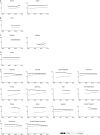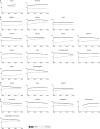The International Epidemiology of Lung Cancer: Latest Trends, Disparities, and Tumor Characteristics
- PMID: 27364315
- PMCID: PMC5512876
- DOI: 10.1016/j.jtho.2016.05.021
The International Epidemiology of Lung Cancer: Latest Trends, Disparities, and Tumor Characteristics
Abstract
Introduction: Our aim was to update global lung cancer epidemiology and describe changing trends and disparities.
Methods: We presented country-specific incidence and mortality from GLOBOCAN 2012 by region and socioeconomic factors via the Human Development Index (HDI). Between- and within-country incidence by histological type was analyzed by using International Agency for Research on Cancer data on cancer incidence on five continents. Trend analyses including data from the International Agency for Research on Cancer, cancer registries, and the WHO mortality database were conducted using joinpoint regression. Survival was compared between and within countries and by histological type.
Results: In 2012, there were 1.82 and 1.59 million new lung cancer cases and deaths worldwide, respectively. Incidence was highest in countries with a very high HDI and lowest in countries with a low HDI (42.2 versus 7.9 in 100,000 for males and 21.8 versus 3.1 in 100,000 for females, respectively). In most countries with a very high HDI, as incidence in males decreased gradually (ranging from -0.3% in Spain to -2.5% in the United States each year), incidence in females continued to increase (with the increase ranging from 1.4% each year in Australia to 6.1% in recent years in Spain). Although histological type varied between countries, adenocarcinoma was more common than squamous cell carcinoma, particularly among females (e.g., in Chinese females, the adenocarcinoma-to-squamous cell carcinoma ratio was 6.6). Five-year relative survival varied from 2% (Libya) to 30% (Japan), with substantial within-country differences.
Conclusions: Lung cancer will continue to be a major health problem well through the first half of this century. Preventive strategies, particularly tobacco control, tailored to populations at highest risk are key to reducing the global burden of lung cancer.
Keywords: Disparity; Epidemiology; Histological type; International; Lung cancer; Survival.
Copyright © 2016 International Association for the Study of Lung Cancer. Published by Elsevier Inc. All rights reserved.
Figures


References
-
- Torre LA, Bray F, Siegel RL, Ferlay J, Lortet-Tieulent J, Jemal A. Global cancer statistics, 2012. CA Cancer J Clin. 2015;65:87–108. - PubMed
-
- Bosetti C, Malvezzi M, Rosso T, et al. Lung cancer mortality in European women: trends and predictions. Lung Cancer. 2012;78:171–8. - PubMed
-
- Ferlay J, Steliarova-Foucher E, Lortet-Tieulent J, et al. Cancer incidence and mortality patterns in Europe: estimates for 40 countries in 2012. Eur J Cancer. 2013;49:1374–403. - PubMed
MeSH terms
Grants and funding
LinkOut - more resources
Full Text Sources
Other Literature Sources
Medical

